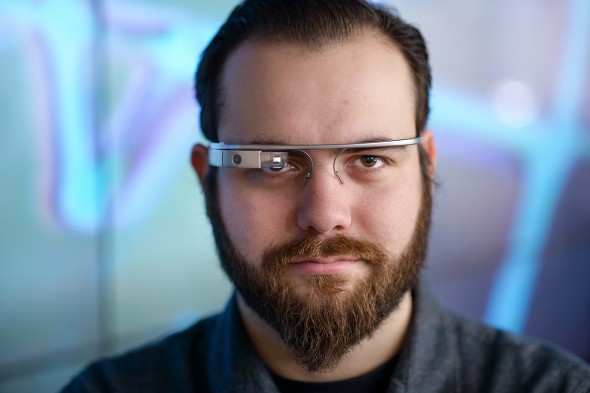Seeing future of technology in Google Glass

Doctoral student Victor Mateevitsi is testing Google Glass, a hands-free smartphone that lets the user browse apps, shoot video and receive directions. “People are exploring what you can do with it,” he says. Photo: Lance Long/Electronic Visualization Laboratory
Smartphones, smart watches and now smart glasses?
That’s right, Google Glass is the latest innovation in smartwear that transforms the way we communicate.
Google Glass is essentially a hands-free smartphone that uses voice recognition and a touchpad system to let the person wearing the glasses browse apps, shoot video, receive directions, and more — without reaching for a phone.
“It’s something new,” said Victor Mateevitsi, doctoral student in computer science.
“People are still exploring what you can do with it. The processing power is not great, you need heavy video real-time image processing, like object recognition is really difficult, but you know it’s going to happen eventually.”
The frameless, lightweight glasses have a number of useful features, including the ability to direct your eyes at a website, sign or other material with text and translate it into another language in seconds. A recent upgrade prompts a wink from your right eye to capture a picture.
Simply say, “OK, Glass, share to Facebook,” and you’ve shared something in a matter of seconds.
“It’s a different way of communicating with the data that is online and communicating with the world around you,” Mateevitsi said.
Glass is currently available only through the Glass Explorer Program to those testing the $1,500 product. A retail version is expected to be released later this year at a cheaper price.
For now, the technology is still in its early phase with developers like Mateevitsi working on projects to expand its uses.
“When the first iPhone appeared, you could only make calls and send text messages, but eventually they added an app store and apps,” he said. “I think it’s all about the apps right now, just writing the correct apps that will make this an experience that you would like to have.”
The Google Glass experience may drastically alter the way we interact with our environment, Mateevitsi said.
Imagine walking through a store looking for a product. Google Glass instinctively brings up a pop-up with pricing at other stores, he said. Or walking into a house decorated in white and, with Glass, visualize what the countertops would look like in marble or the walls blue.
“There is a lot of potential for augmented reality apps,” Mateevitsi said, “when the reality is augmented with information that is virtual and computed on the Glass.”
These advancements are not without problems and critics.
“There definitely are privacy questions, which as a society we need to find answers to,” Mateevitsi said. “Because what happens if I’m wearing Google Glass and I’m recording you, but you don’t know about it?”
The Five Points Cafe in Seattle already placed a ban on Google Glass, citing privacy as a concern. A Columbus, Ohio, man was questioned by Homeland Security after he was suspected of recording a movie for pirating. A California woman was issued a ticket in October for driving while wearing Google Glass, but was cleared because of insufficient proof that they were turned on.
“Think about in the future — the more we use the technology, the more we augment our world and the more we can make,” Mateevitsi said.
OK, Glass. What’s next?
